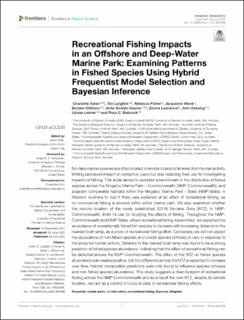Recreational Fishing Impacts in an Offshore and Deep-Water Marine Park: Examining Patterns in Fished Species Using Hybrid Frequentist Model Selection and Bayesian Inference
Aston, Charlotte; Langlois, Tim; Fisher, Rebecca; Monk, Jacquomo; Gibbons, Brooke; Giraldo-Ospina, Anita; Lawrence, Emma; Keesing, John; Lebrec, Ulysse; Babcock, Russ C.
Peer reviewed, Journal article
Published version
Permanent lenke
https://hdl.handle.net/11250/3066142Utgivelsesdato
2022Metadata
Vis full innførselSamlinger
- NGI articles [1061]
Originalversjon
10.3389/fmars.2022.835096Sammendrag
No-take marine reserves are often located in remote locations far away from human activity, limiting perceived impact on extractive users but also reducing their use for investigating impacts of fishing. This study aimed to establish a benchmark in the distribution of fished species across the Ningaloo Marine Park – Commonwealth (NMP-Commonwealth), and adjacent comparable habitats within the Ningaloo Marine Park - State (NMP-State), in Western Australia to test if there was evidence of an effect of recreational fishing, as no commercial fishing is allowed within either marine park. We also examined whether the remote location of the newly established (2018) No-take Zone (NTZ), in NMP-Commonwealth, limits its use for studying the effects of fishing. Throughout the NMP-Commonwealth and NMP-State, where recreational fishing is permitted, we expected the abundance of recreationally fished fish species to increase with increasing distance to the nearest boat ramp, as a proxy of recreational fishing effort. Conversely, we did not expect the abundance of non-fished species and overall species richness to vary in response to the proxy for human activity. Distance to the nearest boat ramp was found to be a strong predictor of fished species abundance, indicating that the effect of recreational fishing can be detected across the NMP-Commonwealth. The effect of the NTZ on fished species abundance was weakly positive, but this difference across the NTZ is expected to increase over time. Habitat composition predictors were only found to influence species richness and non-fished species abundance. This study suggests a clear footprint of recreational fishing across the NMP-Commonwealth and as a result the new NTZ, despite its remote location, can act as a control in future studies of recreational fishing effects.
